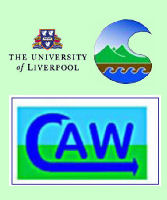|
Ghana ratified the Convention of Biological Diversity
(the CBD) in August 1994 and is a lead player in the area of wetland
management in Africa. However there remain major impediments to
achieving sustainable wetland management within Ghana in particular and
West Africa in general. Previous studies conducted to obtain baseline
information on the status of biodiversity in the country have revealed a
lack of local expertise and taxonomic resources on river fauna in
general and aquatic macroinvertebrates in particular. Priorities to
improve the situation include taxonomic capacity building, assessment of
the status of existing aquatic biodiversity, the development of
practical tools to use in the management of rivers and increased
engagement of local stakeholders in decision making about how they are
managed. Finally, there is a need to promote an enhanced environmental
awareness throughout Ghanaian society.
The priorities will be addressed in this project by a
combination of activities including increased training of local and
regional staff, the development of appropriate
taxonomic resources for
the identification of indigenous aquatic organisms, the deployment of
these resources in a one year long assessment of the current status of
aquatic communities in some example Ghanaian rivers, the production of
educational materials for users at various levels of expertise, the
development of a set of nested indicators of ecosystem health adapted
for use within West Africa, and the production of a policy document
outlining the means of applying the Ecosystem Approach in the management
of Ghana's rivers
The effective management of lotic habitats is very
important since they support local livelihoods and can be associated
with disease (e.g. Onchocerciasis). Assessing the current status of the
ecosystem health of the area will allow more informed environmental
management decisions to be made. By engaging local communities and other
stakeholders and raising the environmental awareness at various levels
(from school children to water managers), public participation in
decision making will be enhanced. Increasing the taxonomic capacity of
local institutions will promote more frequent future monitoring of
aquatic ecosystems and more effective sustainable management of their
resources, protecting their biodiversity at the same time as local
livelihoods.
In general, knowledge of stream biology in the
tropics is patchy and accurate taxonomy is of particular concern
(Jackson and Sweeney, J. of the N. American Benth. Soc., 1995, 14,
5-11). Previous studies by Prof. Gordon (co-ordinator in Ghana) have
shown that this is true for lotic invertebrates in Ghana (Thorne,
Williams and Gordon, 2000, J. of Freshwater Ecology, 15, 209-217). Ghana
also lacks the financial resources to carry out the systematic water
quality analysis which would be required to monitor the health of its
aquatic ecosystems using chemical monitoring. Biological monitoring is
less dependent on expensive equipment and can provide adequate
information to improve management of the system. As well as more
technical outputs, this project will be used to develop simple field
guides which could be used by teachers and school children and community
groups to collect valuable information, as well as helping the public to
learn about the environment.
By strengthening the taxonomic capacity of
researchers, enhancing environmental awareness throughout society,
developing practical management tools for rivers, assessing the current
status of riverine biodiversity in a selection of rivers and increasing
the engagement of stakeholders in environmental decision making, the
project will support the Government's implementation of Articles 7, 12,
13 and 18 of the Convention of Biological Diversity. Particular emphasis
will be placed on the Ecosystems Approach, Inland Waters Biodiversity
and Public Education and Awareness themes.
|

